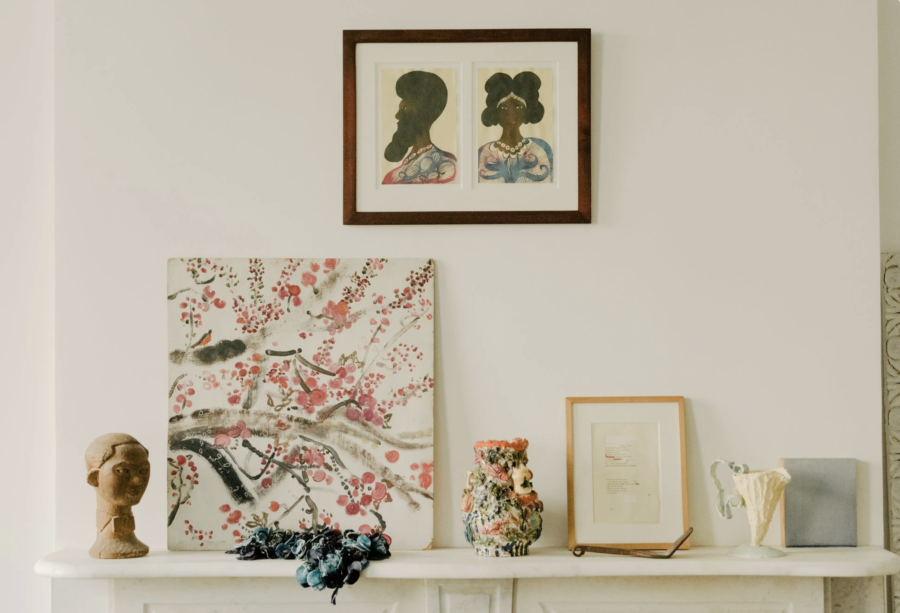February 12, 2019
Download as PDF
View on The New York Times

Top, Chris Ofili’s “King and Queen” (1998). Bottom, from far left: wood sculpture by an unknown artist; Bill Lynch’s “Cherry Blossoms” (1992); multiple velvet necklaces by Polly Applebaum, circa 1990; a French vase; Paul Bloodgood’s “Untitled” (1994); Anne-Marie McIntyre’s untitled sculpture; and Verne Dawson’s “Untitled” (landscape on cigar box).Credit…Daniel Dorsa for The New York Times
On the day in 1983 when Laura Hoptman graduated from Williams College, she took a bus to Manhattan and moved into an apartment on East 10th Street. “I knew I wanted to be in the contemporary-art world, I knew I wanted to be a curator, but most of all, I knew I just wanted to be around artists,” said Ms. Hoptman,
now executive director of the Drawing Center. Over the last three decades, she’s achieved the life she envisioned, and it’s reflected on the walls of the home she shares with her husband, the painter Verne Dawson, at another address on East 10th.
“For me, 10th Street means something special because it’s where I first started out, and it has art historical importance from the 1950s,” Ms. Hoptman said, noting that it has been home to influential galleries like Reuben and Tanager, Willem
de Kooning’s studio and the critic Harold Rosenberg, who once lived directly downstairs from her apartment.
“I showed my first paintings on 10th Street at a short-lived place called the Olsen Gallery in 1984,” said Mr. Dawson, an Alabama native who came to New York
to study at Cooper Union. In March, he has shows opening at Gavin Brown’s Enterprise and Galerie Eva Presenhuber in New York.
The couple’s grown-up bohemian apartment is filled with artworks accumulated from their network of friends and colleagues, including Elizabeth Peyton, Rirkrit Tiravanija, Paul Bloodgood, Trisha Donnelly, Chris Ofili and George Condo — all of whom Ms. Hoptman has worked with during her curatorial career, which has also taken her to the Bronx Museum of the Arts, the Museum of Modern Art, the Carnegie Museum of Art and the New Museum.
The couple got a vibrant circular canvas by Ugo Rondinone in exchange for a portrait of his husband, John Giorno, by Mr. Dawson.
Ms. Hoptman and Mr. Dawson met in the late ’80s when she was in graduate school at the Institute of Fine Arts at N.Y.U. “Verne introduced me to all the artists I started working with,” she said, calling him a “back-story guru.”
These are edited excerpts from the conversation. So Verne has been your secret weapon?
LAURA HOPTMAN Absolutely, and not secret at all. Verne was like a key. I did have a couple of my own artist friends. Everyone always says I discovered Gabriel Orozco. I truly did discover him in an elevator of a gallery building when he couldn’t speak any English. I thought he was super handsome and gave him my phone number. It was an accident that he turned out to be a great artist.
Are there pieces here you are particularly sentimental about?
VERNE DAWSON That work with the family of monkeys, over the mantel, is by Bill Lynch. He was a close friend of mine who passed away in 2015 at 53 and became schizophrenic as he aged. During his life, he had never had a real show. I organized an exhibition, the only show I ever curated, at White Columns after he died. His mother asked me to pick a painting out from the show to have. He painted this on the backing of a cheap mirror with broken glass. I like the blackness of it, sort of the opposite of the light of a mirror. I feel it does almost all those things a mirror does, only differently.
HOPTMAN That’s a soul stick by Jim Lambie. When I left MoMA to go to the Carnegie, a bunch of people bought me this to take with me so I could have magic powers.
Did it work?
HOPTMAN Well, I put it in the Carnegie International. It was leaning against the wall. I’ve never lent anything except for that.
Is everything here a gift or trade or have you bought any of the works?
DAWSON I never spent more than $20 on a work. This odd vase [with a damaged octopus on the front] I bought for 5 euros on a stoop sale in Paris and I’ve probably made 20 different paintings of it.
HOPTMAN I think I bought three things in my entire life. That candle drawing by Raymond Pettibon I could afford and got when I was a graduate student.
DAWSON I say, “Why would you buy bread when your husband’s a baker?”



